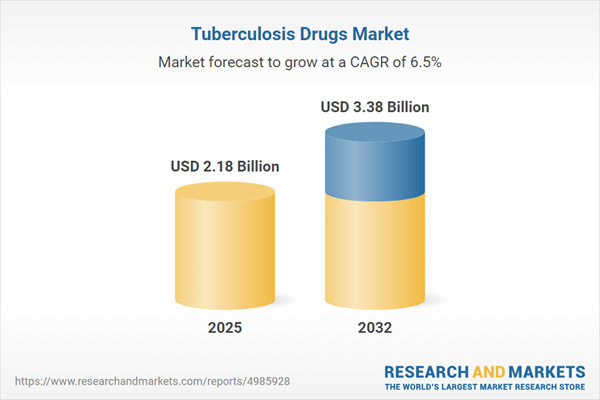Speak directly to the analyst to clarify any post sales queries you may have.
The tuberculosis drugs market is at a pivotal stage, marked by significant advancements in therapeutics and evolving policy landscapes, requiring decisive leadership from industry stakeholders. Critical factors—including scientific breakthroughs, regulatory action, and strategic alliances—are shaping the competitive and operational dynamics of this sector, demanding proactive approaches from senior decision-makers.
Market Snapshot: Tuberculosis Drugs Market
The tuberculosis drugs market grew from USD 2.04 billion in 2024 to USD 2.18 billion in 2025. It is expected to continue growing at a CAGR of 6.46%, reaching USD 3.38 billion by 2032. The market demonstrates high growth potential as new drug approvals and efficient regulatory frameworks catalyze global access. Stakeholders must manage shifting supply chain and policy environments while responding to the persistent threat of drug-resistant strains. Favorable collaborative strategies and digital health integrations are increasingly important, especially in high-burden regions and emerging markets.
Scope & Segmentation
- Route of Administration: Injectable and oral formulations, with injectables improving adherence in community programs and oral therapies supporting outpatient care.
- Treatment Regimen: Individualized regimens, long-course, and short-course approaches to accommodate patient-specific needs and evolving resistance patterns.
- Tuberculosis Type: Pulmonary and extrapulmonary tuberculosis, each influencing clinical strategies and drug demand due to differing diagnostic and treatment complexities.
- Distribution Channel: Hospital pharmacies, online pharmacies, and retail pharmacies, each playing a unique role in access, patient support, and adherence promotion.
- Geographic Regions: Americas (with focus markets including United States, Canada, Mexico, Brazil, Argentina, Chile, Colombia, Peru), Europe, Middle East & Africa (including United Kingdom, Germany, France, Russia, Italy, Spain, Netherlands, Sweden, Poland, Switzerland, United Arab Emirates, Saudi Arabia, Qatar, Turkey, Israel, South Africa, Nigeria, Egypt, Kenya), and Asia-Pacific (including China, India, Japan, Australia, South Korea, Indonesia, Thailand, Malaysia, Singapore, Taiwan).
- Key Companies: Johnson & Johnson, Lupin Limited, Cipla Limited, Viatris Inc, Sun Pharmaceutical Industries Limited, Otsuka Pharmaceutical Co., Ltd., Dr. Reddy’s Laboratories Limited, Teva Pharmaceutical Industries Limited, Glenmark Pharmaceuticals Limited, F. Hoffmann-La Roche Ltd.
Key Takeaways for Decision-Makers
- Continued emergence of multi-drug resistant tuberculosis drives demand for novel compounds and redefined treatment paradigms across diverse care settings.
- Shorter, more tolerable treatment regimens and digital adherence technologies are enhancing both the patient experience and clinical outcomes.
- Individualized therapy and precision medicine are gaining traction, particularly in high-burden and resource-constrained regions.
- Distinct segmentation by administration route, regimen, and disease type enables pharmaceutical leaders to tailor portfolios to most promising commercial and public health opportunities.
- Regional differences in regulatory frameworks and market access underscore the importance of local partnerships and adaptive resource allocation.
- Leading companies are prioritizing integration with public health agencies, technology transfer initiatives, and advanced logistic models to optimize outcome-oriented market penetration.
Tariff Impact: United States Tariffs on Tuberculosis Drug Supply Chains
The implementation of new tariffs in the United States has altered cost dynamics for manufacturers importing active pharmaceutical ingredients or finished products. Companies are revising sourcing strategies, shifting towards local manufacturing, or leveraging tariff-exempt supply routes. These changes influence contract negotiations, distribution flows, and end-user pricing, ultimately affecting institutional procurement decisions and patient access. The evolving tariff landscape places a premium on agile supply chain management and robust scenario planning for sustained market resilience.
Methodology & Data Sources
This analysis uses a hybrid research model combining primary and secondary data. Structured interviews and surveys with opinion leaders, clinicians, procurement specialists, and patient advocates supplement an extensive systematic review of clinical trials, regulatory filings, and industry publications. Data validation employs triangulation, ensuring insight accuracy and actionable guidance on market trajectories and emerging dynamics.
The Value of This Tuberculosis Drugs Market Report
- Actionable intelligence enables executives to benchmark strategic moves, anticipate disruption, and identify growth segments fastest benefiting from advanced tuberculosis therapies.
- Comprehensive segmentation and regional insights help leaders align investment and access strategies with evolving patient and policy landscapes.
- Focused recommendations equip decision-makers to navigate regulation, incorporate innovative digital and clinical technologies, and foster partnerships for long-term value creation.
Conclusion
The tuberculosis drugs market is evolving rapidly, driven by scientific, operational, and policy shifts. Senior leaders who adopt informed, adaptive strategies will enhance access, reinforce stakeholder value, and shape the future standard of care for tuberculosis treatment.
Additional Product Information:
- Purchase of this report includes 1 year online access with quarterly updates.
- This report can be updated on request. Please contact our Customer Experience team using the Ask a Question widget on our website.
Table of Contents
3. Executive Summary
4. Market Overview
7. Cumulative Impact of Artificial Intelligence 2025
Companies Mentioned
The companies profiled in this Tuberculosis Drugs market report include:- Johnson & Johnson
- Lupin Limited
- Cipla Limited
- Viatris Inc
- Sun Pharmaceutical Industries Limited
- Otsuka Pharmaceutical Co., Ltd.
- Dr. Reddy’s Laboratories Limited
- Teva Pharmaceutical Industries Limited
- Glenmark Pharmaceuticals Limited
- F. Hoffmann-La Roche Ltd
Table Information
| Report Attribute | Details |
|---|---|
| No. of Pages | 190 |
| Published | October 2025 |
| Forecast Period | 2025 - 2032 |
| Estimated Market Value ( USD | $ 2.18 Billion |
| Forecasted Market Value ( USD | $ 3.38 Billion |
| Compound Annual Growth Rate | 6.4% |
| Regions Covered | Global |
| No. of Companies Mentioned | 11 |









